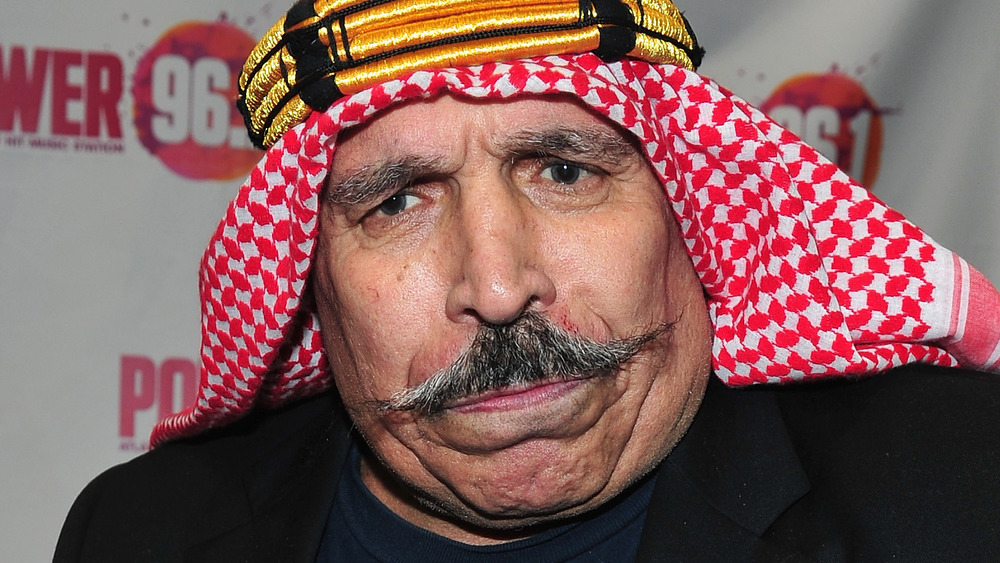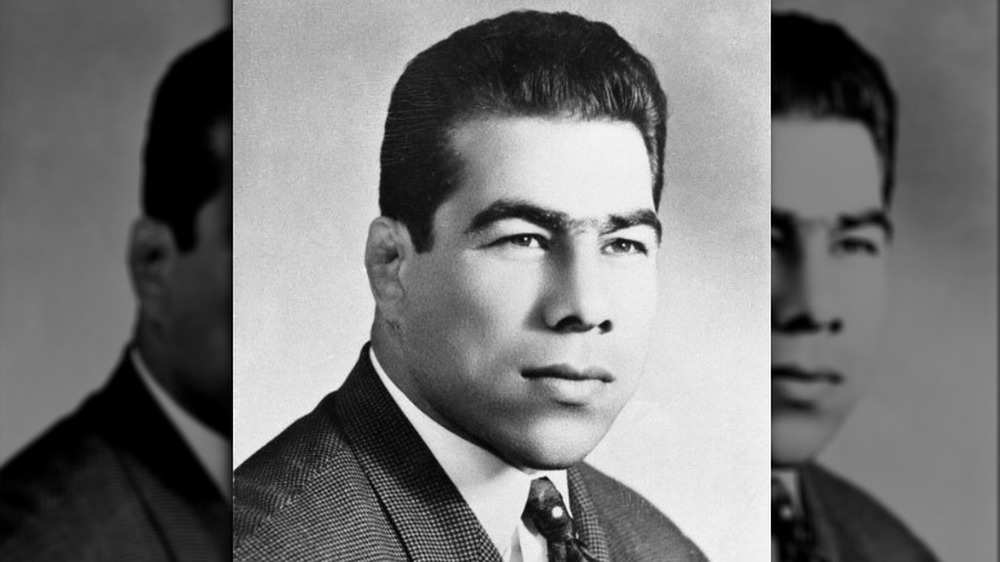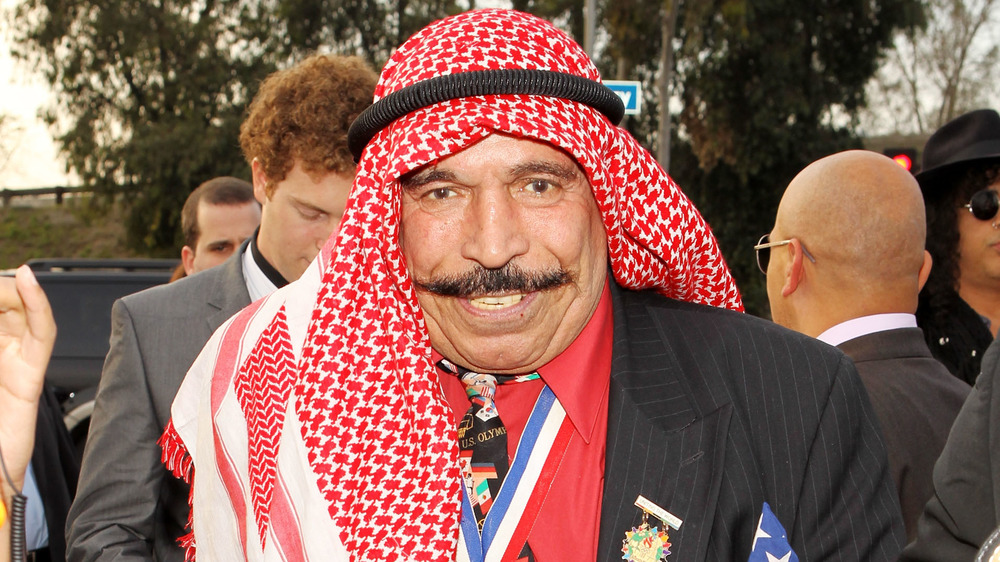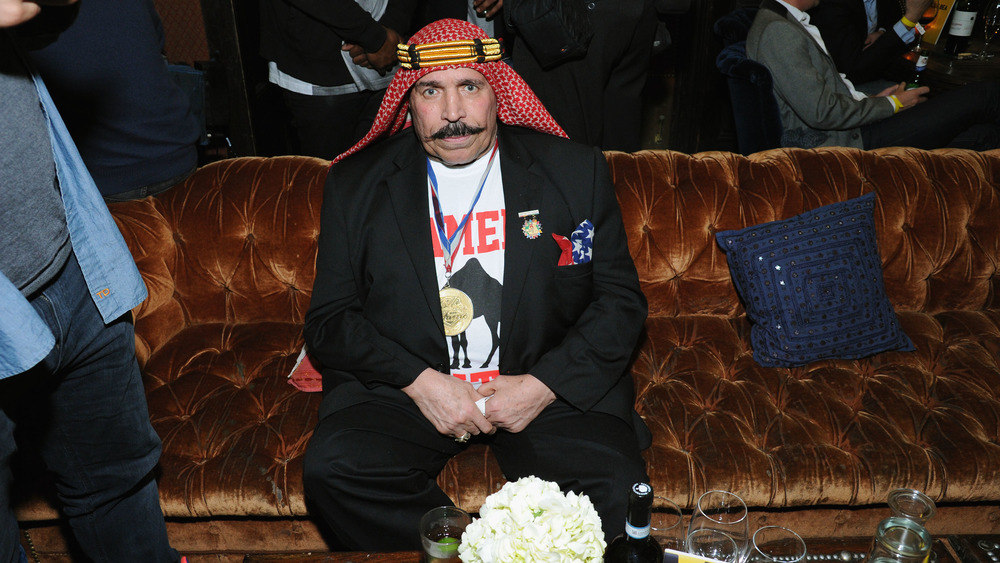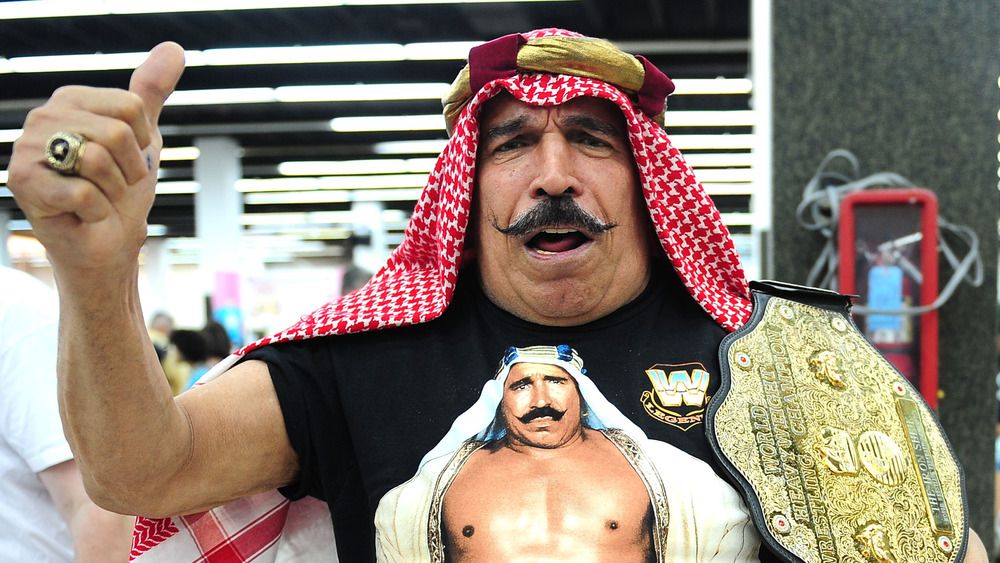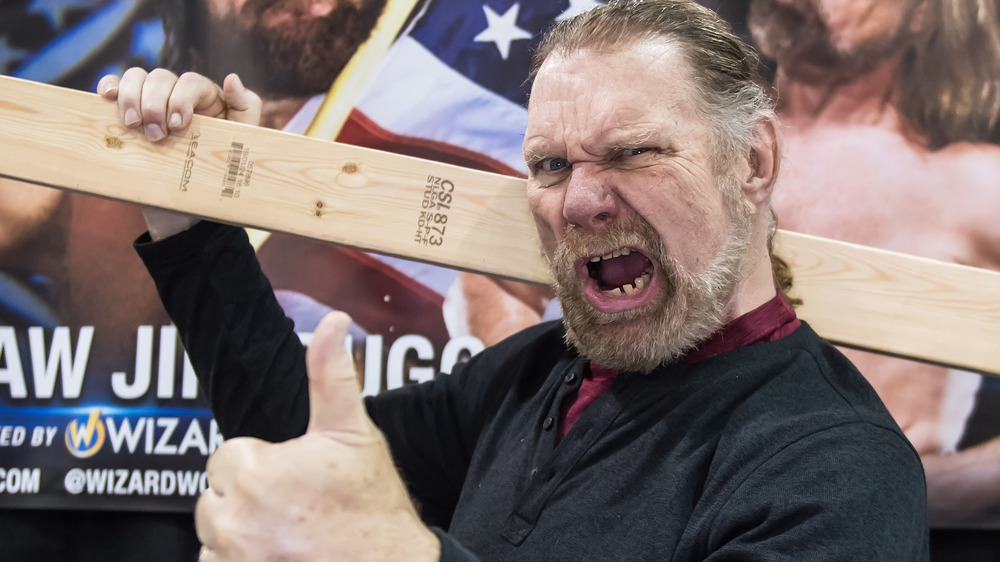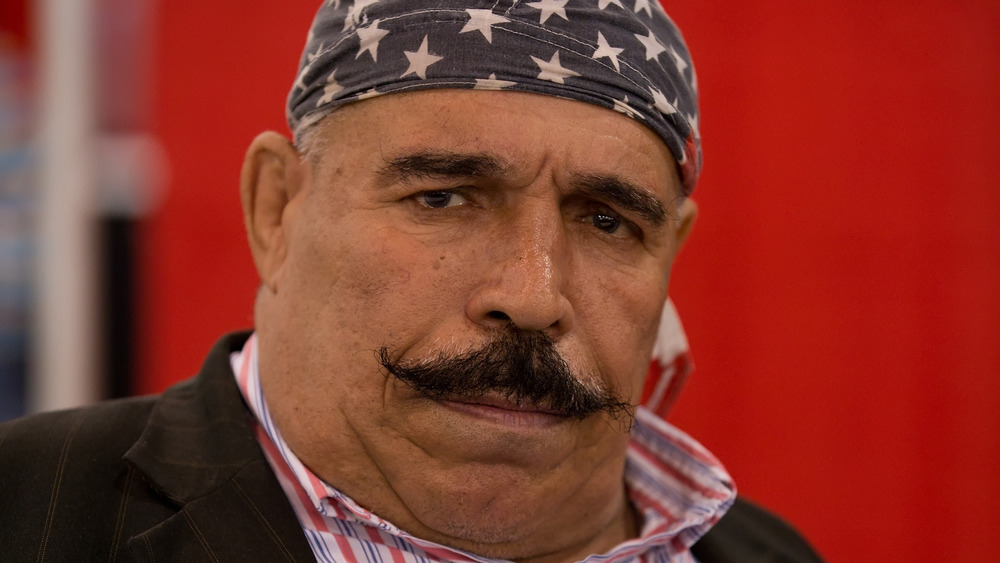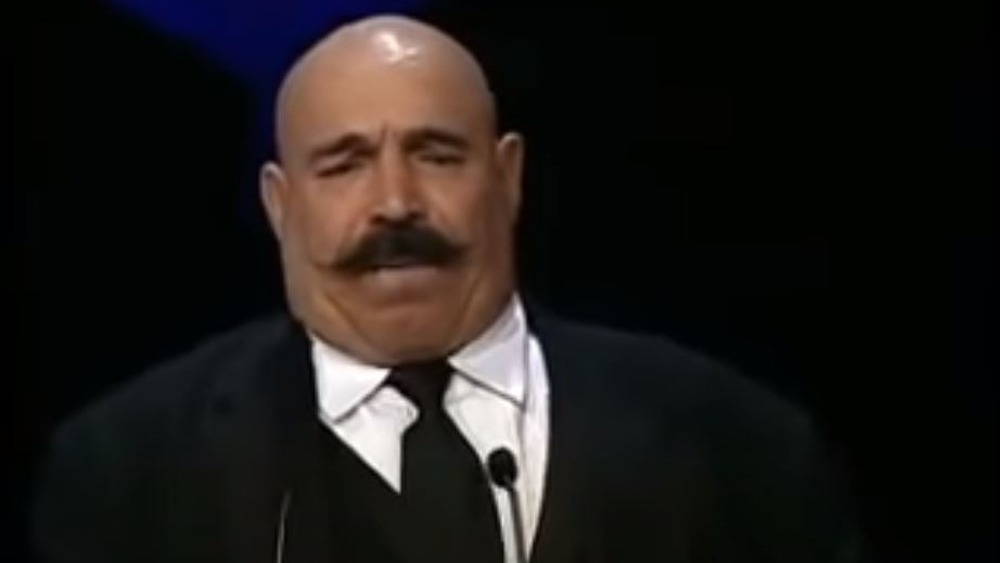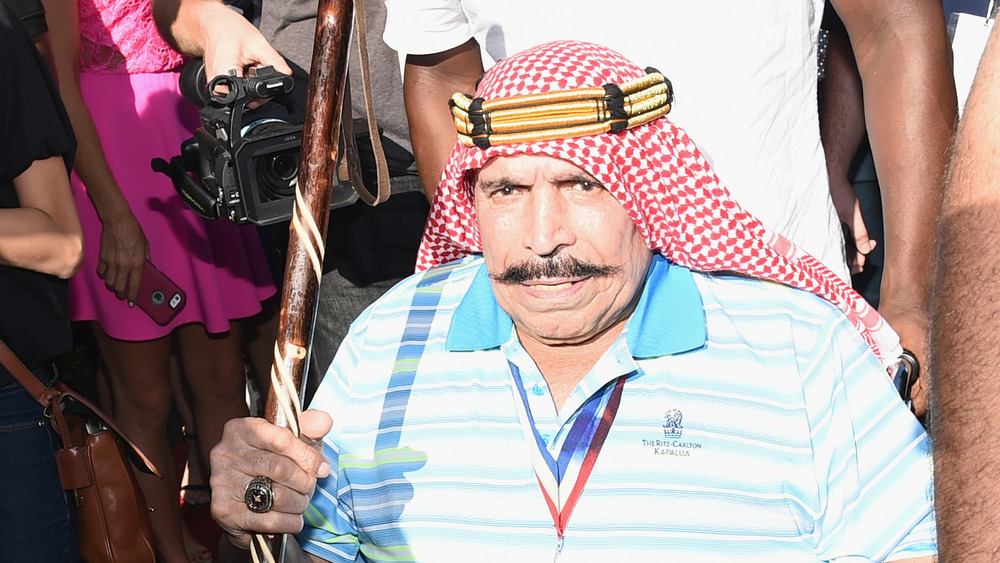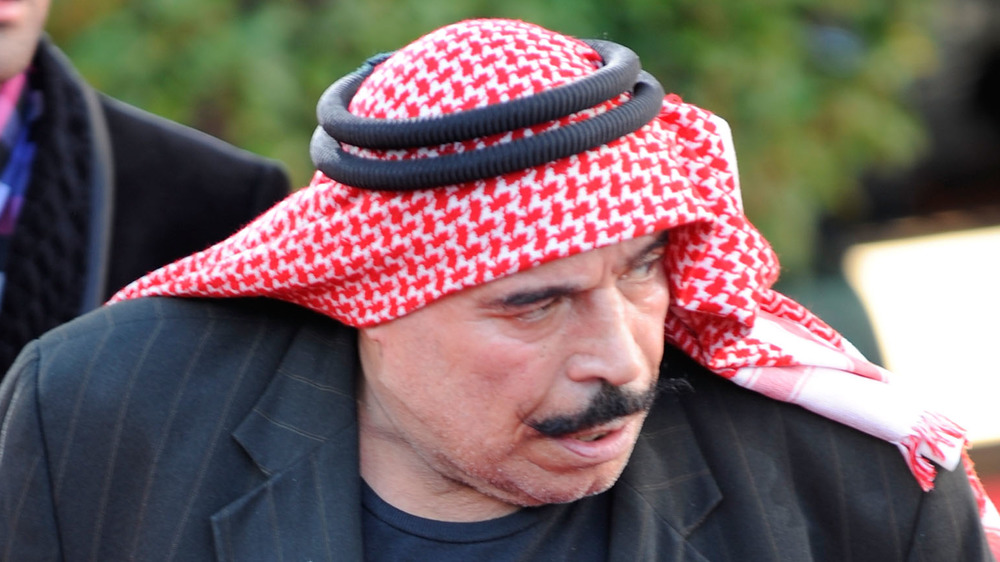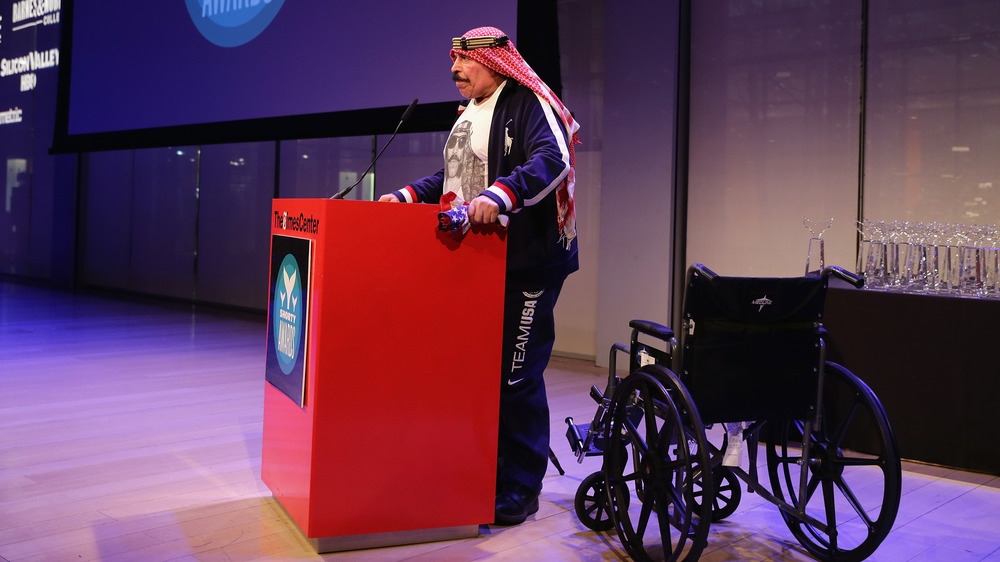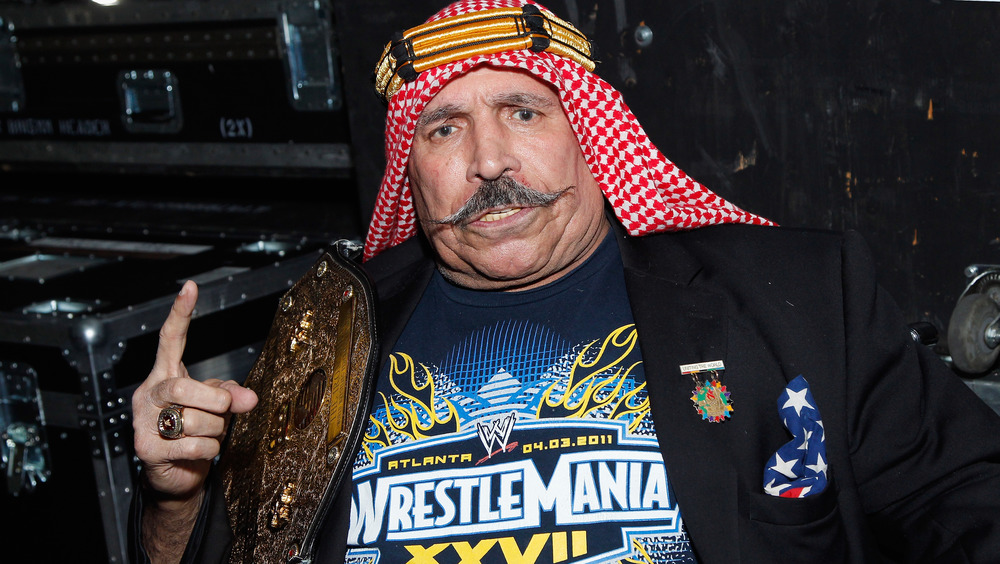The Tragic Real-Life Story Of The Iron Sheik
His name is Hossein Khosrow Ali Vaziri, but you almost certainly know him by his more famous moniker: The Iron Sheik. From his enormously successful career as a pro wrestler to his later fame as an intense and profane social media personality, the Sheik's bombastic, confrontational character has enticed multiple generations. Unfortunately, the price Vaziri has paid for his career has been extremely steep. His life was never particularly easy to begin with, and even as his fame rose, various problems and misfortunes started piling up. On June 7, 2023, The Iron Sheik passed away. He was 81.
Pro wrestlers are very, very good at staying in character, so there's a pretty good chance that you've never guessed just how difficult things were for this seemingly unbudgeable strongman who looks like he's ready to take on the entire world at a moment's notice. Today, we peek behind the curtain and delve deep into the tragic real-life story of The Iron Sheik.
The Iron Sheik spent his youth in poverty
In an industry of scripted events, plotlines, and characters, it would be easy enough to imagine that the Iron Sheik was actually just some dude from Akron, Ohio, who had a talent for accents and whose mustache game is on point. This couldn't be further from the truth. According to Lew Freedman's book Pro Wrestling: A Comprehensive Reference Guide, the future Sheik really spent his early days in Iran's capital, Tehran.
The honorific of his wrestling character wasn't very accurate, though, because his family was actually quite poor. According to Bidoun, Hossein Khosrow Ali Vaziri was born in 1943 to a pistachio-farming family. He spent his early days without amenities such as running water, and as he grew up, he had to go through mandatory military service. This was presumably no picnic, but as a small silver lining, it did give him ample time to hone his wrestling craft and even become the army's wrestling champion.
The fall of a hero
So, how did a young man from Iran end up dominating stateside pro wrestling rings? By being disillusioned by the mysterious death of his hero.
As Bidoun tells us, the reason the Iron Sheik became interested in wrestling is a man named Gholamreza Takhti (pictured), an Olympic gold medalist in freestyle wrestling. The extremely famous Takhti hailed from the same neighborhood as the future Sheik, so he was a natural role model for Hossein Khosrow Ali Vaziri — and the young man soon found himself on a similar career path. "I wanted to show my parents I could be big just like him," he commented. He definitely did that, and in barely any time, too: Only three years after taking up wrestling, Vaziri was a national high school champion. Per Bleacher Report, he later taught his children many of his tricks of this era.
While Vaziri's love for wrestling would endure for decades to come, the man who inspired him met an untimely end. Takhti died in 1968, and although the official explanation was that he'd killed himself, there were whispers that the athlete had been "taken care of" because he'd been getting too political. The news made young Vaziri realize that his trajectory and Takhti's were too close for comfort. "I knew I had to leave," he said. "If Iran was not good for eh-Takhti, it was not good for me." And so, the Sheik went to America.
The Iron Sheik's connection to Iran often made life difficult for him
As Lew Freedman's Pro Wrestling: A Comprehensive Reference Guide tells us, the 1980s was not a good time to be a famous foreign villain. The Iron Sheik was able to draw heat and become successful, but it reflected pretty badly on his personal life. The Sheik was such a successful baddie that, as Yahoo! Sports notes, he earned up to $500,000 a year in his heyday — somewhere between $1.2 and $1.6 million in today's money, adjusted for inflation and depending on the year. Unfortunately, this money came at a cost that was far higher than getting booed on a nightly basis. Multiple wrestling fans attempted to beat the Sheik up or even stab him. In an interview with Vice, he recalled one instance when he had to leave a venue hiding in an ambulance, terrified of the mobs outside. Things got so bad that he started to fear for the safety of his family and stopped taking them on the road.
A big reason why the Sheik was such a good villain — and why people sometimes wanted a piece of him — is the simple fact that he hails from Iran. In 1979, the country's revolutionaries held 52 American citizens hostage for no less than 444 days, which didn't do any favors for Iran's reputation in the U.S.
The Iron Sheik's beloved medals were stolen
Though the Iron Sheik's "evil foreigner" gimmick and various villainous antics may be the most enduring image of his wrestling career, it should be remembered that he was also a very, very good wrestler. Bleacher Report notes that when he still lived in Iran, he was a common sight in international tournaments. Things didn't exactly cool down when he moved stateside, and Bidoun tells us that his accolades of this era include the gold medal in the 1971 AAU (Amateur Athletic Union) championship — as well as two silvers in the two years before. He was also a good enough wrestling coach to serve a stint as an assistant coach for the U.S. Olympic team.
The Sheik was very proud of his medals, and much like Olympic gold-winning pro wrestler Kurt Angle after him, he liked to keep his bling on full display during his TV appearances. Unfortunately, this proved to be too tempting for some, and the Sheik reportedly lost his precious prizes when they were stolen from his hotel room in Newark, New Jersey.
The Iron Sheik had trouble staying out of character
It would be easy to think that after a long, hard day of acting as a magnet for America's hatred, loathing, and dropkicks, the Iron Sheik liked nothing better than to drop the character and kick back as his own good self. Unfortunately, Bleacher Report tells us that he found this quite difficult. When he was starting out in the 1970s, the Sheik came from a legitimate amateur wrestling background, and he found it hard to accept the scripted nature of pro wrestling. "This is my sport," he told his trainer, Verne Gagne. "I cannot be phony."
Turns out, the Sheik was a good learner — and as he settled into his character, he became so adept at "being phony" that he often stayed in the role in his downtime. This was, of course, a bit of a problem, since the Iron Sheik was a cartoonish wrestling heel. Sometimes, things got so bad that he started randomly dictating what individual people could buy and eat ... while they were shopping in the supermarket. Considering what a massive name the Sheik was in his prime, the modern equivalent for this would probably be if the MCU villain Thanos suddenly ambushed you at Walmart to berate you about the amount of microwave meals in your cart.
Iron Sheik and Hacksaw Jim Duggan made a big mistake
The Iron Sheik might have caused plenty of in-ring havoc in his prime, but as TheSportster tells us, one of his most notorious victims was the very concept of kayfabe itself. "Kayfabe," if you're not familiar with wrestling jargon, is the pro wrestling industry's system of keeping up appearances. Basically, the heroic "faces" and villainous "heels" play their designated roles and steer clear of each other in public, no matter how well they privately get along.
In 1987, the Sheik inadvertently put a massive dent in this idea when he ended up in hot water with a fellow wrestler, "Hacksaw" Jim Duggan. As the Associated Press reported at the time, the pair were driving to an event together and were arrested when it turned out they had marijuana and, in the case of the Sheik, cocaine. This was a minor problem. However, as Bleacher Report notes, the huge problem was that Duggan and the Sheik were a face and a heel, happily traveling in the same car. This caused massive waves in the wrestling circles, and as a result, the World Wrestling Federation promptly fired both men. If you ask Duggan, the injury came with a side order of insult because thanks to this incident, the pair were often perceived as buddies. "The worst thing about that whole arrest with me and the Iron Sheik is that folks think me and the Sheik are friends," Duggan has stated. Ouch.
The Iron Sheik's daughter was murdered
A wrestler's life may be tragic, but that doesn't mean that every single tragedy in his life is wrestling-related. Few people know this better than the Iron Sheik who, as Yahoo! Sports reports, once suffered quite possibly the worst thing that can happen to a parent: His child was murdered. On May 3, 2003, Marissa Vaziri was strangled to death by her boyfriend, Charles Warren Reynolds. She was 27 years old. According to Bleacher Report, the murderer committed the crime in the aftermath of a party and later said to the police: "She's such a good girl, but she wouldn't calm down."
Marissa's death was a massive blow to the Sheik, both because it happened and because he was completely unable to do anything about it. "He was this big strong guy that everyone had relied on for so long," his wife later said. "And in this situation, there was nothing he could do to save her. It devastated him that he couldn't have been there and tried to save her."
The Iron Sheik's razor blade revenge plan
As Bleacher Report tells us, the 2003 murder of Iron Sheik's daughter was an understandably tough time for the wrestling legend. All the sorrow and anger led him to such a dark place that when he went to attend the trial of the culprit, Charles Warren Reynolds, the Sheik hid a razor blade in his mouth in order to slice into the killer's throat.
Fortunately, the wrestler's wife, Caryl, had caught wind of his intentions and was fully aware that the Sheik could very likely tear through the officials in order to make good on his plans. The Vaziri family confronted their patriarch, and one of his surviving daughters, Tanya, had some words for her dad. "You can't kill him 'cause they'll put you in prison," she said. "I lost my sister and I don't want to lose my father." This brought the Sheik to his senses, and he abandoned his bloody plans on the spot.
The Iron Sheik struggled with addiction
Though the Iron Sheik was a stern and dedicated athlete for many of his days, Yahoo! Sports tells us that his life and career alike suffered from his long-term substance abuse issues. He was already struggling with a crack cocaine addiction during his heyday, but that was far from the only intoxicant he developed a taste for. What's worse, he was known to mix alcohol with whatever drugs he could get his hands on.
According to Bleacher Report, the Sheik's devotion to both his sport and his Shiite Muslim beliefs meant that he steered clear of the more carnal aspects of life for longer than most. Likewise, he didn't bother with drink and drugs until the pro wrestling community's liberal approach to narcotic substances swept him off his feet. The stories of the Sheik's intoxicated misadventures remain the stuff of industry legend, and unfortunately, he wasn't above getting his fellow wrestlers in trouble — whether by hiding his drugs in their clothes while waiting to cross the Canadian border or by suplexing them through hotel room beds.
Though the Sheik attempted to clean up his act at times, he had more than his share of relapses, and his addiction bled into his personal life, as well. He had at least one bender that ended in a minor heart attack, and at one point, his wife temporarily left him because of his drug use.
The Iron Sheik struggled with depression
Going purely by his character, the Iron Sheik might have seemed like the most self-assured person in the world. However, the man behind the impressive mustache went through some dark days, and he reportedly struggled with depression in various points of his life. Per Bidoun, the first time the Sheik fell in "deep depression" was when he was still living in Iran, and his idol, famed wrestler Gholamreza Takhti, died in what were thought to be somewhat suspicious circumstances. This prompted the future pro wrestling legend to start a new life in the United States.
As Bleacher Report tells us, another, even more hurtful loss came in 2003, with the murder of the Sheik's daughter. Though his immediate reaction was to swear off drugs in order to better aid his grieving family, he eventually found the grief too much to bear and started using again. It was during this hazy period that he started his late-life side gig as shock jock Howard Stern's foul-mouthed guest, and Bleacher Report describes his tantrums of the time as "fueled by drugs and emotional destitution."
Fortunately, the Sheik was able to kick drugs after his wife finally left him. They eventually reconciled, and by 2013, he seemed to occupy a much healthier mental space.
The Iron Sheik suffered many injuries
Per Bleacher Report, the Iron Sheik's wife, Caryl, has made it clear that she has little regard for old-school professional wrestling after seeing what it did to her husband. "The person you love is far away, hurting his body," she's said. "And when it's over, at least in his era, you're not prepared for any other line of work. There are so many injuries, you can't even do manual labor."
This is hardly surprising, considering the sheer amount of physical punishment her husband absorbed through the years. According to Yahoo! Sports, the Sheik's cumulative injuries took their toll, and his left knee in particular was severely wrecked, to the point that he had an extremely difficult time walking. TheSportster notes that as of 2016, the Sheik's body was so spent that he required a cane to move about. A couple of years earlier, the New York Post revealed that during a trip to the Big Apple, he relied on a wheelchair. What's more, decades of grappling left him with a series of joint injuries that were so extensive they would reportedly require multiple surgeries — which he couldn't afford.
The Iron Sheik lived in constant pain
A professional wrestler can't get to the top of the industry without experiencing his share of pain, and the Iron Sheik's tolerance for unpleasant physical sensation was quite significant. After all, Bleacher Report notes that in his younger days, he was the kind of guy who'd spend a nice family picnic standing in the icy waters of the nearby Buford Dam, drawing long looks from passersby.
Unfortunately, even the Sheik had his limits, and as Yahoo! Sports tells us, his thoroughly worn-down and broken body reached them long ago. "He's in such great pain, almost all the time," the Sheik's wife, Caryl Vaziri, said in 2013. A part of this nigh-constant torment comes from the natural wear and tear from a life as a pro wrestler, but Caryl named a pair of botched knee surgeries around 2003 as the main culprit. "He hurts everywhere, but the knees are really painful," she once said. "He told me, 'Caryl, I hurt from the top of my head to the bottom of my toes.'"
This kind of constant torture makes one suspect that if the Sheik could have rewound time, he'd go for a very different career path. However, the wrestling legend appeared to adamantly disagree. "I love wrestling and I would do it all again," the Iron Sheik has said. "But it is a very, very hard business. There is nothing about it that is easy."
